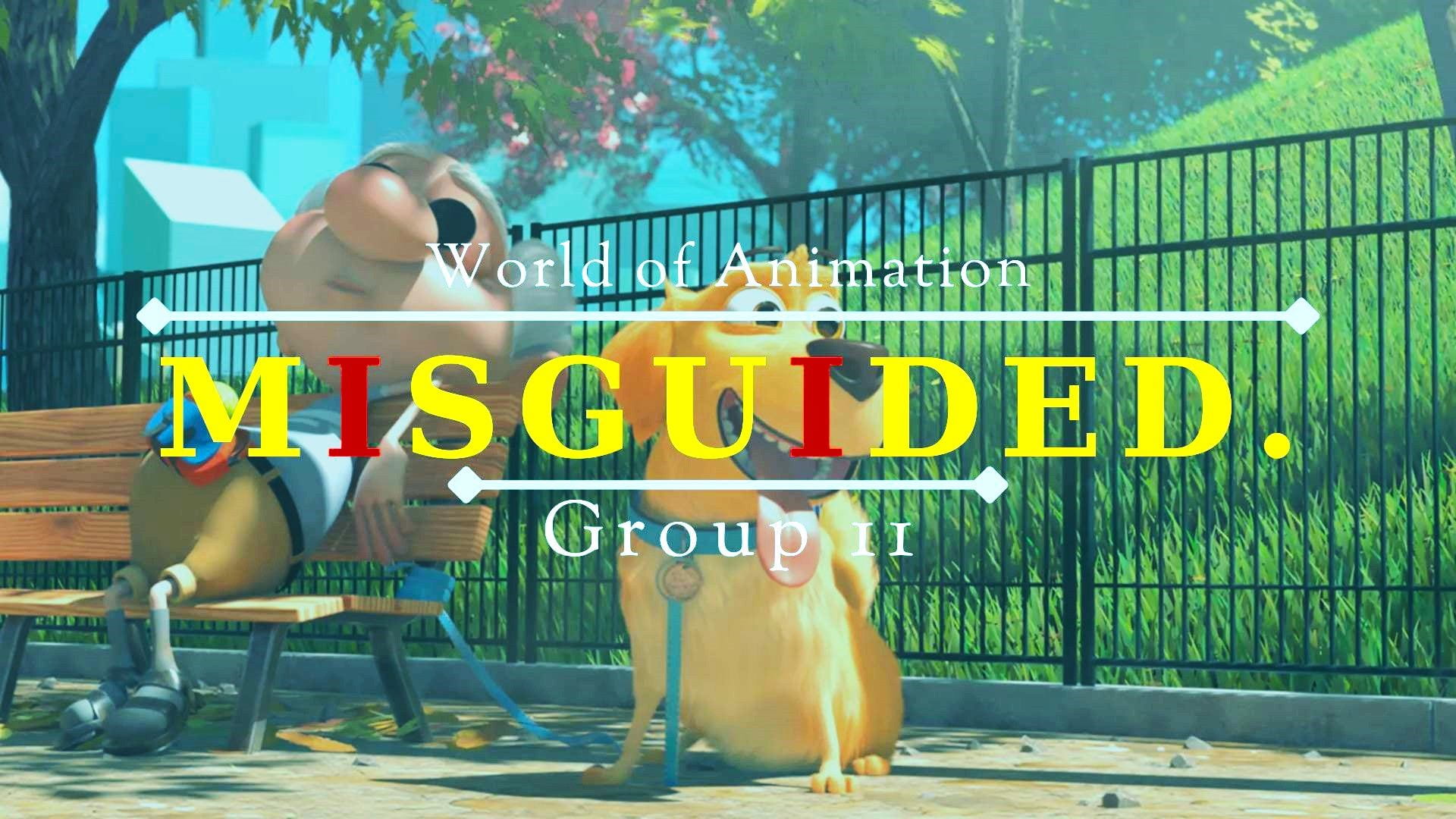
In this assignment, my group analysed the award-winning animated comedy short ‘Misguided,’ created by Sanghyun Kim at the Ringling College of Art and Design, which is centred around the exploits of a clumsy and easily distracted guide dog Tom, who must navigate the dangers of a construction site to save his blind and deaf master, Albert.
Having already covered elements of cinematography, mise-en-scene, and sound in some depth on previous courses, to gain understanding of a different area, I instead chose to research the origins of the storytelling narrative purported to be behind this, and every story ever told – the Hero’s Journey or Monomyth.
A concept originally presented in Joseph Campbell’s 1949 acclaimed work, ‘The Hero with a Thousand Faces,’ and later adapted into a condensed, more practical storywriter’s guide, ‘The Writer’s Journey’ by Christopher Vogler, the premise of the monomyth is that every story, in every culture, be it a myth, folk tale, dream or movie, shares the same common narrative structure, and character archetypes.
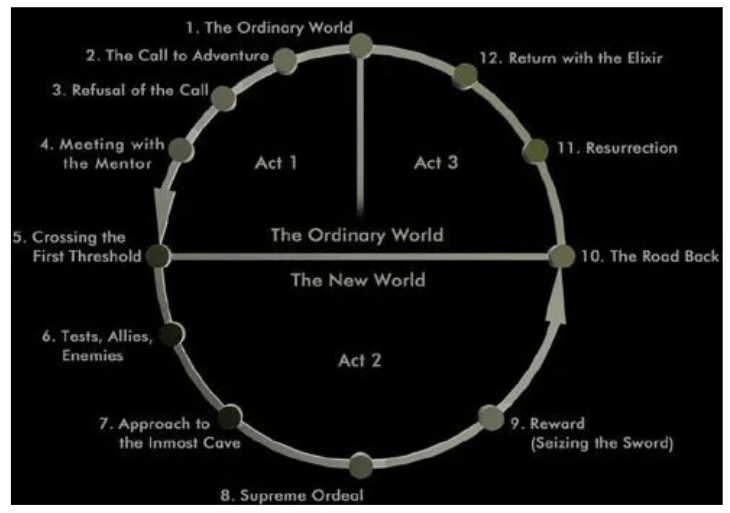
The 12 Steps of the Writer’s Journey Source: Myers, 2016
With a three-act structure first defined by Aristotle almost 2,300 years ago (Sullivan, Schumer and Alexander, 2008), Vogler’s Writer’s Journey, is split into 12 stages; key events that can be rearranged, added to, or some omitted to ensure that the audience remain entertained and engaged throughout. Indeed, as this guide became Hollywood ‘gold,’ and every blockbuster movie follows this pattern, omitting a stage can create tension and make the audience pay closer attention when the storyline they encounter is not what they were expecting (Film Courage, 2023a).

‘Misguided’ too follows this same pattern, but with an unexpected twist at the end to make the story more memorable and unique. Initially we’re introduced to the hero Tom, the guide dog through whom the story is told; who setting the story in motion, breaks free from the metaphorical constraints of servitude in his mundane, ordinary world, to have a little opportune fun when his ball unexpectedly bounces past him; an act that shows, that like us he’s flawed, and allows the audience to immediately empathise with him and be more invested in his journey (Sullivan, Schumer and Alexander, 2008). However, presenting Tom with a problem, while distracted, his blind master Albert unexpectedly wanders off, and realising that he’s failed in his duty, in a call to adventure, Tom must right this wrong and save him.
At this stage, informing the audience that the unknown world the hero is about to enter is intimidating and dangerous, and that it’s natural for the hero to be afraid, the hero can refuse the call, or receive guidance and encouragement from a usually older and sage mentor (TED-Ed, 2012), but in this case, apparently loyal to Albert, Tom willingly accepts the call, and crossing the first threshold, he ventures into the dangerous, unfamiliar environment of the construction site, where building tension, the audience follows Albert’s chaotic and perilous journey, and in rising conflict, see Tom face and comedically overcome a series of challenging tests.
We are gripped, when Tom approaches the innermost cave (the most dangerous spot in the special world), the scaffolding, which confronting danger he must climb to save Albert, and where at the top he faces his greatest fear – the ordeal – the psychological life or death moment when the audience are held in suspense, not knowing if Albert will live or die as he precariously wobbles back and forth on the top girder, and we prematurely celebrate on seeing Tom’s delight to have survived, and be able to restore, what we think is order to his world.

Finally, achieving his goal, Tom takes possession of the treasure he was seeking – the reward, which we believe is that he’s saved Albert. However, after making a misguided decision, in an unexpected twist, Tom has saved his ball instead, but breathing a sigh of relief, we can relax knowing that in an uncanny twist of fate, Albert has also miraculously survived.
The remaining stages – the road back, resurrection, and return with the elixir are then only touched upon, and while there is normally a tidy resolution, in another clever twist we are left with more questions than answers, when in the credits roll and Tom appears scratching at a door with a ‘cone of shame’ on his head, and what might be the starting point for another story.
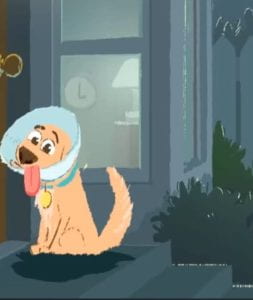
CHARACTER ARCHETYPES
Based on the hypothesis of Carl G. Jung (a psychoanalyst who studied dreams and linked common images within them to a collective unconsciousness to which we’re all attuned), there are also recurring archetypal characters that appear over and over again in all stories; each with a specific dramatic function, and a backstory which makes them relatable to the audience (Sullivan, Schumer and Alexander, 2008; Film Courage, 2023b).
Tom is the main protagonist and hero archetype. In Greek, hero means “to protect and serve” (Campbell, 2008), which is exactly what, as the faithful and unselfish guide dog, we expect Tom to do. But in an unexpected twist, and showing that character archetypes don’t have to be rigid; after a misguided decision, Tom becomes a fallen hero when he decides to save his ball instead.
In contrast, Albert is the Trickster/Ally archetype, who with comedic effect, moves the story along in a chaotic manner and provides new opportunities; his actions setting up one scene for the next, and providing the means for drama, escalation and de-escalation within the story. Indeed, without Albert leading the hero off track, there is no story. He adds purpose to the plot, and the audience can’t help but react to his slapstick ways.
With every story having lineage, and as the author of ‘O Pioneers!,’ Willa Cather once wrote, ‘There are only two or three human stories and they go on repeating themselves as fiercely as if they had never happened before,’ the ‘Misguided’ storyline and characters are undoubtedly inspired by an earlier work, with in this case Albert’s character likely inspired by Mr. Magoo from the Oscar-winning 1960’s UPA animation series. Like Albert, Mr Magoo is a visually impaired retiree who gets himself into chaotic and comical situations with disastrous effects. Also mirroring the ‘Misguided’ storyline, the other characters suffer the consequences of Mr Magoo’s actions, and just like Albert, Mr Magoo’s uncanny streak of luck always seems to leave him none the worse for wear.

REFLECTION
Reflecting on this part of the module, I can honestly say I’ve thoroughly enjoyed the lectures, and am looking forward to the next World of Animation task. Regarding the assignment, while the reading, research, notetaking and presentation preparation took significantly more time compared to if I’d chosen an element I was already familiar with, going the extra mile has given me new knowledge and perspective, particularly in relation to animated shorts, that I can use in my future projects.
Given that the authors of one of the sources, ‘Ideas for the Animated Short: Finding and Building Stories’ are also lecturers at Ringling College where the ‘Misguided’ short was made, I was especially interested to read their material on storyline creation and structure, and to compare this guidance with our animated short. In doing so, I also learned interesting differences between full-length animated features and shorts; for example:
- to have economy in structure (reduced stages),
- limit the story to one character that ‘wants something badly and is having trouble getting it’ (Iglesias, 2010),
- that one other character and/or environment should be the cause of conflict,
- and to elicit an emotional and psychological response, this conflict should intensify to the point where the hero is in crisis and has a difficult choice to make.
Using different mediums, ranging from books to YouTube videos, also made the research element of the task much less tedious, with examples of the notes taken, with support, from YouTube interviews I watched, where Christopher Vogler himself explains his Writer’s Journey and character archetypes shown below.
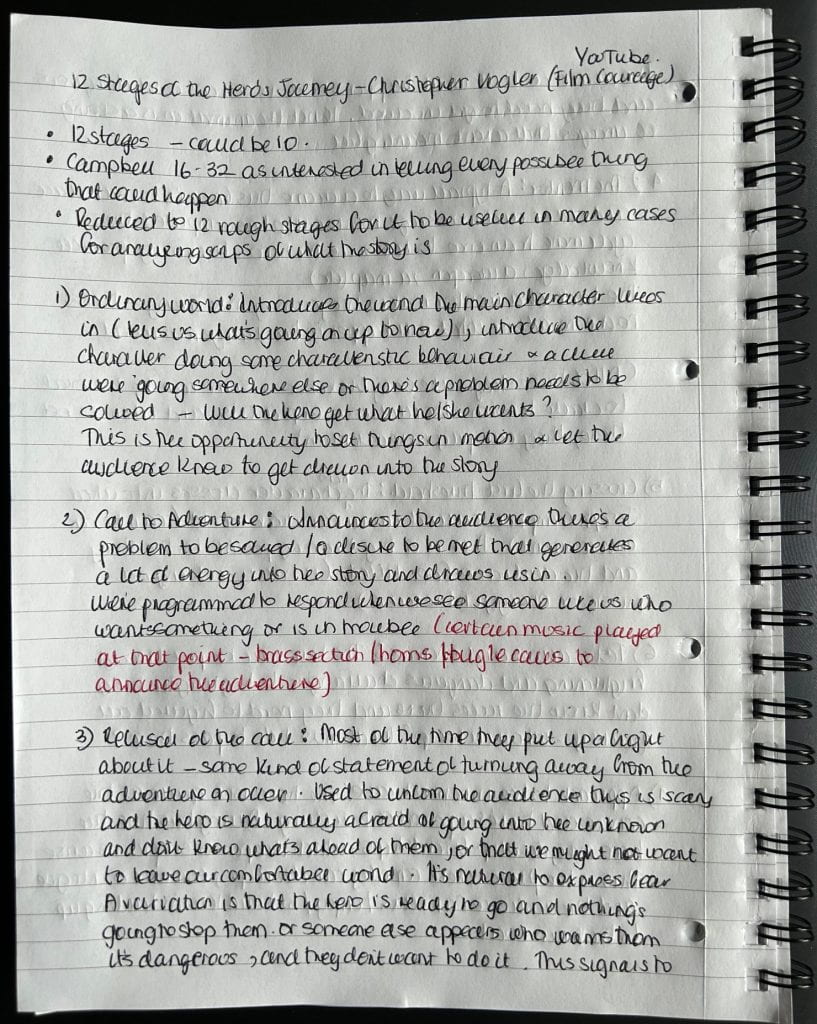

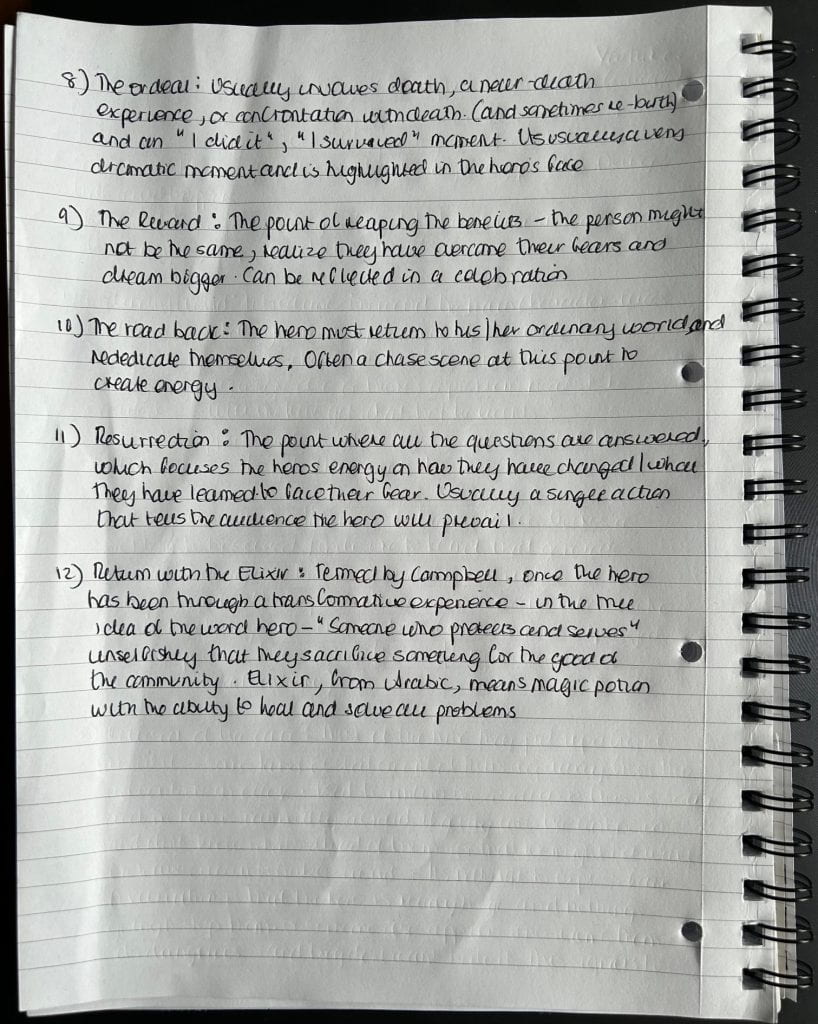
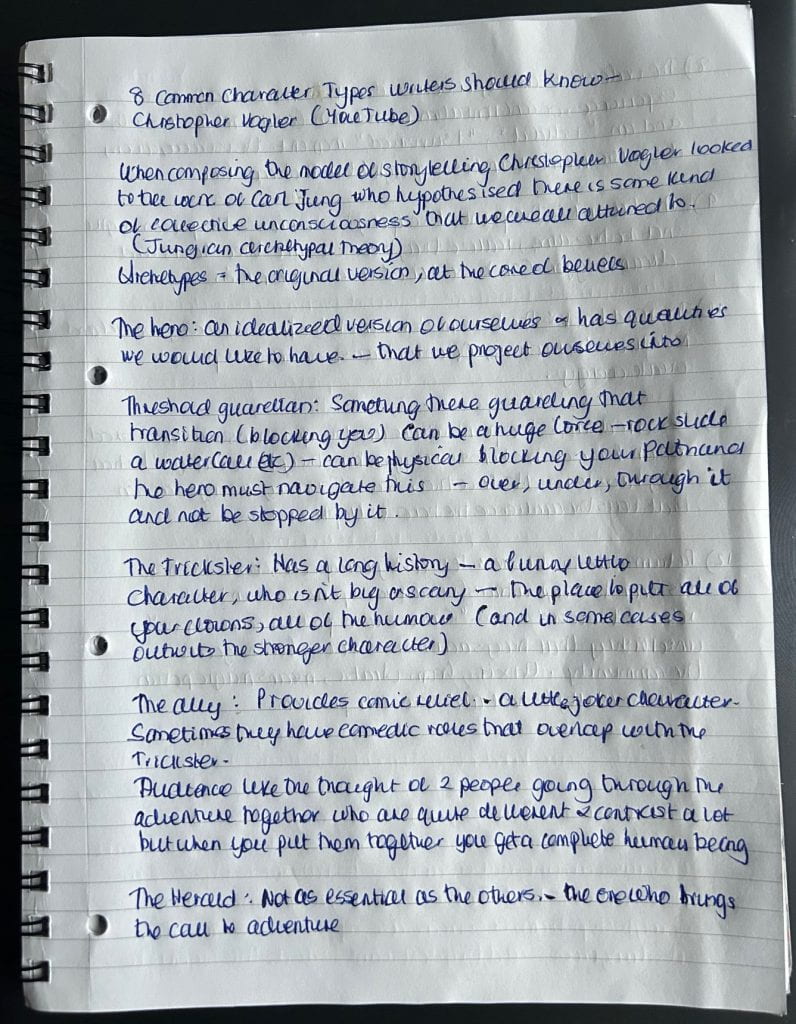
Notes from YouTube interviews where Christopher Vogler explains his Writer’s Journey, and character archetypes
Having found teamworking problematic last semester, I’m happy to say that even with a team member absent during our tutorial session, our group worked well together, and once the areas to be covered had been allocated, everyone played their part to produce, what I believe, was a good presentation. While everyone wasn’t available at the same time to discuss the project on Discord, team communication was good, with messages answered quickly, and the presentation completed on time. Unfortunately, with everyone not available at the same time, there wasn’t an opportunity for a run through the presentation beforehand, but every team member timed their section to ensure the overall presentation didn’t run over the allocated time.
Using Canva was also a blessing and a curse, in that the team could all work on the same presentation at once, but while similar to PowerPoint, as it was a platform I had never used before, it took me a little longer at first to create my slides. With group presentations a focus next year, I was also happy to have the opportunity to develop my presentation skills, and that growing in confidence I was able to move away from the more fussy slide content below, to a more attractive and minimal visual form.


However my confidence still needs to grow to the point that I’m able to deliver the information independently, or with prompt cards, instead of simply reading it from a sheet, and despite my communication skills deficits, although I tried to engage with the audience by looking up at everyone during my presentation, there’s much more I can do to improve in this area. Nevertheless, l found this assignment interesting, and despite the daunting prospect of more reading, writing and notetaking in the next part of the module, I’m up for the challenge!
Below is a link to both the ‘Misguided’ YouTube video and my presentation slides:
 Loading...
Loading...
References:
Campbell, J. (2008). The Hero with a Thousand Faces. 3rd ed. Novato, Calif.: New World Library.
Film Courage. (2023a). 12 Stages Of The Hero’s Journey – Christopher Vogler. YouTube. [Accessed 25 February 2024].
Available at: https://www.youtube.com/watch?v=oNNaMuBOxv4
Film Courage.(2023b). 8 Common Character Types Writers Should Know – Christopher Vogler. [online]. [Accessed 27 February 2024].
Available at: https://www.youtube.com/watch?v=I0fEdNWwcG0&list=PLez8jOvskc-OFbFPTf03N8PZBwcjK5VJt
Iglesias, K. (2010). Writing for emotional impact advanced dramatic techniques to attract, engage, and fascinate the reader from beginning to end. Livermore, Calif. Wingspan Press.
Myers, S. (2016). Joseph Campbell’s ‘The Hero’s Journey’. [online] Medium. [Accessed 27 Feb 2024].
Image available at: https://gointothestory.blcklst.com/joseph-campbells-the-hero-s-journey-a7eae9677965
Sullivan, K., Schumer, G. and Alexander, K. (2008). Ideas for the Animated Short: Finding and Building Stories. Amsterdam; Boston: Focal Press. [Accessed 12 February 2024].
Available at: https://virgam.files.wordpress.com/2010/12/anim-draw-48-ssa-ideas-shorts.pdf
TED-Ed (2012). What makes a hero? – Matthew Winkler. YouTube. [online]. [Accessed 5 February 2024].
Available at: https://www.youtube.com/watch?v=Hhk4N9A0oCA
Vogler, C. (2007). The Writer’s Journey: Mythic Structure for Writers. 3rd ed. [online]. Studio City, Ca: Michael Wiese Productions. [Accessed: 5 February 2024].
Available at: https://mseffie.com/assignments/genre/Writers%20Journey%20Full.pdf
